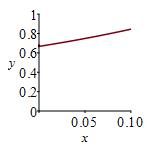24. Applications of Taylor Series
c.2. Integrals (Requiring the Taylor Bound on the Remainder)
In the examples and exercises on the previous page, the series were all alternating. So we could use the alternating series bound to bound the remainder. In the following exercises, the series is not alternating. So you will need to use the Taylor bound on the remainder.
Find the Maclaurin series for \(\displaystyle f(x)=\int_0^x \dfrac{\ln(1-t)}{t}\,dt\). Find its radius of convergence.
\[ \log(1-t) =\sum_{n=1}^\infty \dfrac{-t^n}{n} =-\,t-\dfrac{t^2}{2}-\dfrac{t^3}{3}-\dfrac{t^4}{4}-\cdots \]
\(\begin{aligned}\displaystyle
\int_0^x \dfrac{\ln(1-t)}{t}\,dt
&=\sum_{n=1}^\infty \dfrac{-x^n}{n^2} \\
&=-x-\dfrac{x^2}{4}-\dfrac{x^3}{9}-\dfrac{x^4}{16}-\cdots
\end{aligned}\)
\(R=1\)
Start with the series: \[ \ln(1-t) =\sum_{n=1}^\infty \dfrac{-t^n}{n} =-\,t-\dfrac{t^2}{2}-\dfrac{t^3}{3}-\dfrac{t^4}{4}-\cdots \] Divide by \(t\): \[ \dfrac{\ln(1-t)}{t} =\sum_{n=1}^\infty \dfrac{-t^{n-1}}{n} =-1-\dfrac{t}{2}-\dfrac{t^2}{3}-\dfrac{t^3}{4}-\cdots \] And integrate: \[\begin{aligned} \int_0^x \dfrac{\ln(1-t)}{t}\,dt &=\left[\sum_{n=1}^\infty \dfrac{-t^n}{n^2}\right]_0^x =\sum_{n=1}^\infty \dfrac{-x^n}{n^2} \\ &=-x-\dfrac{x^2}{4}-\dfrac{x^3}{9}-\dfrac{x^4}{16}-\cdots \end{aligned}\] To find the radius of convergence, we apply the ratio test: \[\begin{aligned} \lim_{n\to\infty}\left|\dfrac{a_{n+1}}{a_n}\right| &=\lim_{n\to\infty} \left|\dfrac{-x^{n+1}}{(n+1)^2}\cdot\dfrac{n^2}{-x^n}\right| \\ &=|x| \lt 1 \end{aligned}\] So the radius of covergence is \(R=1\).
Approximate \(\displaystyle\int_0^{0.1} \dfrac{\ln(1-t)}{t}\,dt\) by the first two terms of the Maclaurin series for \(\displaystyle f(x)=\int_0^x \dfrac{\ln(1-t)}{t}\,dt\). Find a bound on the error in this approximation.
\[\begin{aligned} \int_0^x \dfrac{\ln(1-t)}{t}\,dt &=\sum_{n=1}^\infty \dfrac{-x^n}{n^2} \\ &=-x-\dfrac{x^2}{4}-\dfrac{x^3}{9}-\dfrac{x^4}{16}-\cdots \end{aligned}\]
\(\displaystyle \int_0^{0.1} \dfrac{\ln(1-t)}{t}\,dt
\approx-0.1025\)
\(\left|R_2f(0.1)\right| \le 1.4\times10^{-4}\)
From \[\begin{aligned} \int_0^x \dfrac{\ln(1-t)}{t}\,dt &=\sum_{n=1}^\infty \dfrac{-x^n}{n^2} \\ &=-x-\dfrac{x^2}{4}-\dfrac{x^3}{9}-\dfrac{x^4}{16}-\cdots \end{aligned}\] we get \[\begin{aligned} \int_0^{0.1} \dfrac{\ln(1-t)}{t}\,dt &=\sum_{n=1}^\infty \dfrac{-(0.1)^n}{n^2} \\ &=-(0.1)-\dfrac{(0.1)^2}{4}-\dfrac{(0.1)^3}{9}-\dfrac{(0.1)^4}{16}-\cdots \end{aligned}\] We approximate this by the first \(2\) terms: \[ \int_0^{0.1} \dfrac{\ln(1-t)}{t}\,dt \approx-(0.1)-\dfrac{(0.1)^2}{4}=-0.1025 \] Since the series is not alternating, we need to use the Taylor bound on the remainder. \[ \left|R_2f(0.1)\right| \le \dfrac{M}{3!}|0.1|^3 \qquad \text{where} \qquad M \ge |f\,^{(3)}(t)| \quad \text{on} \quad [0,0.1] \] So we need the \(3^\text{rd}\) derivative: \[\begin{aligned} f(x)&=\int_0^x \dfrac{\ln(1-t)}{t}\,dt \\ f'(x)&=\dfrac{\ln(1-x)}{x} \\ f''(x)&=\dfrac{-1}{x(1-x)}-\dfrac{\ln(1-x)}{x^2} \\ f'''(x)&=\dfrac{(1-2x)}{x^2(1-x)^2} +\dfrac{1}{x^2(1-x)}+2\dfrac{\ln(1-x)}{x^3} \end{aligned}\]
We need the maximum of \(|f\,^{(3)}(x)|\) on \([0,.1]\). So we plot \(|f\,^{(3)}(x)|\). The maximum is at \(x=0.1\).

\[ M=|f\,^{(3)}(0.1)|=\dfrac{(1-2(0.1))}{(0.1)^2(1-(0.1))^2} +\dfrac{1}{(0.1)^2(1-(0.1))}+2\dfrac{\ln(1-(0.1))}{(0.1)^3} =0.844 \] Thus, \[ \left|R_2f(0.1)\right| \le \dfrac{M}{3!}|0.1|^3 =\dfrac{0.844}{6}|0.1|^3=1.4\cdot10^{-4} \]
Heading
Placeholder text: Lorem ipsum Lorem ipsum Lorem ipsum Lorem ipsum Lorem ipsum Lorem ipsum Lorem ipsum Lorem ipsum Lorem ipsum Lorem ipsum Lorem ipsum Lorem ipsum Lorem ipsum Lorem ipsum Lorem ipsum Lorem ipsum Lorem ipsum Lorem ipsum Lorem ipsum Lorem ipsum Lorem ipsum Lorem ipsum Lorem ipsum Lorem ipsum Lorem ipsum